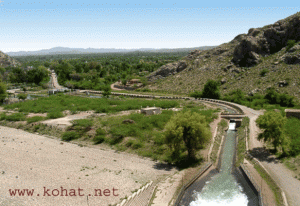Sights and Sounds of Kohat-Last part
Monday, April 16th, 2012 10:43:25 by Naveed A Bari
Sights and Sounds of Kohat-Last part
In its small but carefully tilled glens, the plane, palm, fig and many orchard trees flourish luxuriantly; while brushwood of wild olive, mimosa and other thorny bushes clothes the rugged ravines upon the upper slopes. Occasional grassy glades upon their
sides form favorite pasture grounds for the Waziri tribes.
The Ten Toi, rising on the eastern limit of Upper Miranzai, runs due eastward to the Indus, dividing the district into two main portions. The drainage from the northern half flows southward into the Ten Toi itself, and northward into the parallel stream
of the Kohat Toi.
That of the southern tract falls northwards also into the Ten Toi, and southwards towards the Kurram and the Indus. The Frontier Mountains, continuations of the Safed Koh system, attain in places a considerable elevation, the two principal peaks, Dupa Sir
and Mazi Garh, being 8260 and 7940 ft. above the sea respectively.
The Waziri hills, on the south, extend like a wedge between the boundaries of Bannu and Kohat, with a general elevation of less than 4000 ft. The salt-mines are situated in the low line of hills crossing the valley of the Ten Toi, and extending along both
banks of that river.
The deposit has a width of a quarter of a mile, with a thickness of I000 ft.; it sometimes forms hills 200 ft. in height, almost entirely composed of solid rock-salt, and may probably rank as one of the largest veins of its kind in the world.
The most extensive exposure occurs at Bahadur Khel, on the south bank of the Ten Toi. The annual output is about 16,000 tons. Petroleum springs exude from a rock at Panoba, 23 miles east of Kohat; and sulphur abounds in the northern range.
The indigenous people of Kohat and surrounding areas generally live in houses made of clay, like any other part of the province owing to weather severity and poverty, which are usually clustered in villages. A standard house consists of two or three rooms.
Hujra is an important feature for a cluster of houses where male members interact and is also used as a guestroom.
In urban centers the houses are mostly brick made with modern structure. Men and women wear loose shalwar Kameez while the women folk wrap themselves up with an additional sheet of cloth called " Chaddar " in order to hide her face and figure. Women usually
wear an additional cloak, usually black or white in color called "Burqcr". Men also put on Chitrali caps along with woolen shawl in winter.
Beside many quality educational institutions, Kohat is also home to two prestigious military institutions: The
Inter Services Selection Board (ISSB) and the Cadet College Kohat. The
Kohat University of Science & Technology was established in 2001 and offers advanced studies to the students of the area.
Short URL: https://www.newspakistan.pk/?p=19078

















